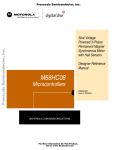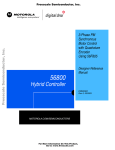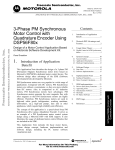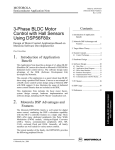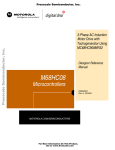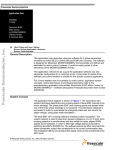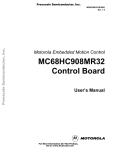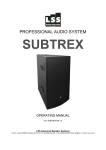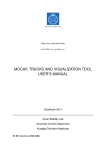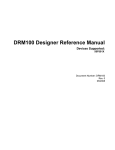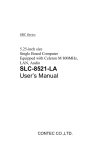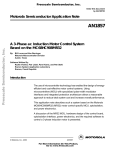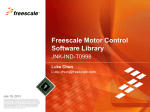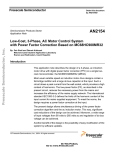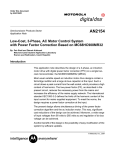Download 3-Phase BLDC Drive Control with Hall Sensors Reference Design
Transcript
Freescale Semiconductor, Inc... Freescale Semiconductor, Inc. 3-Phase BLDC Drive Control with Hall Sensors Reference Design Designer Reference Manual M68HC08 Microcontrollers DRM022/D Rev. 1, 03/2003 MOTOROLA.COM/SEMICONDUCTORS For More Information On This Product, Go to: www.freescale.com Freescale Semiconductor, Inc... Freescale Semiconductor, Inc. For More Information On This Product, Go to: www.freescale.com Freescale Semiconductor, Inc. Freescale Semiconductor, Inc... 3-Phase BLDC Drive Control with Hall Sensors Reference Design Designer Reference Manual — Rev 1 by: Jiri Ryba, Petr Stekl Motorola Czech Systems Laboratories Roznov pod Radhostem, The Czech Republic DRM022 — Rev 1 Designer Reference Manual MOTOROLA 3 For More Information On This Product, Go to: www.freescale.com Freescale Semiconductor, Inc. Revision history To provide the most up-to-date information, the revision of our documents on the World Wide Web will be the most current. Your printed copy may be an earlier revision. To verify you have the latest information available, refer to: http://www.motorola.com/semiconductors Freescale Semiconductor, Inc... The following revision history table summarizes changes contained in this document. For your convenience, the page number designators have been linked to the appropriate location. Revision history Date Revision Level January, 2003 1 Description Initial revision Page Number(s) N/A DRM022 — Rev 1 Designer Reference Manual 4 MOTOROLA For More Information On This Product, Go to: www.freescale.com Freescale Semiconductor, Inc. Designer Reference Manual — 3-ph BLDC Drive Control with Hall Sensors List of Sections Section 1. Introduction . . . . . . . . . . . . . . . . . . . . . . . . . . . 13 Freescale Semiconductor, Inc... Section 2. System Description. . . . . . . . . . . . . . . . . . . . . 15 Section 3. Hardware Design. . . . . . . . . . . . . . . . . . . . . . . 23 Section 4. Software Design . . . . . . . . . . . . . . . . . . . . . . . 37 Section 5. Application Setup . . . . . . . . . . . . . . . . . . . . . . 47 Appendix A. References. . . . . . . . . . . . . . . . . . . . . . . . . . 61 Appendix B. Glossary. . . . . . . . . . . . . . . . . . . . . . . . . . . . 63 DRM022 — Rev 1 Designer Reference Manual MOTOROLA 5 For More Information On This Product, Go to: www.freescale.com Freescale Semiconductor, Inc. Freescale Semiconductor, Inc... List of Sections DRM022 — Rev 1 Designer Reference Manual 6 MOTOROLA For More Information On This Product, Go to: www.freescale.com Freescale Semiconductor, Inc. Designer Reference Manual — 3-ph BLDC Drive Control with Hall Sensors Table of Contents Freescale Semiconductor, Inc... Section 1. Introduction 1.1 Contents . . . . . . . . . . . . . . . . . . . . . . . . . . . . . . . . . . . . . . . . . .13 1.2 Overview. . . . . . . . . . . . . . . . . . . . . . . . . . . . . . . . . . . . . . . . . .13 1.3 Brief Description . . . . . . . . . . . . . . . . . . . . . . . . . . . . . . . . . . . . 13 1.4 68HC908MR32 Features . . . . . . . . . . . . . . . . . . . . . . . . . . . . . 14 Section 2. System Description 2.1 Contents . . . . . . . . . . . . . . . . . . . . . . . . . . . . . . . . . . . . . . . . . .15 2.2 Application Features . . . . . . . . . . . . . . . . . . . . . . . . . . . . . . . . . 15 2.3 Brushless DC Motor Theory . . . . . . . . . . . . . . . . . . . . . . . . . . . 17 2.4 Digital Control of BLDC Motor . . . . . . . . . . . . . . . . . . . . . . . . . 19 Section 3. Hardware Design 3.1 Contents . . . . . . . . . . . . . . . . . . . . . . . . . . . . . . . . . . . . . . . . . .23 3.2 Hardware Configuration . . . . . . . . . . . . . . . . . . . . . . . . . . . . . . 23 3.3 MC68HC908MR32 Control Board . . . . . . . . . . . . . . . . . . . . . . 25 3.4 3-Ph BLDC Low Voltage Power Stage . . . . . . . . . . . . . . . . . . . 27 3.5 EVM Motor Board . . . . . . . . . . . . . . . . . . . . . . . . . . . . . . . . . . .29 3.6 Optoisolation Board . . . . . . . . . . . . . . . . . . . . . . . . . . . . . . . . . 31 3.7 3-Phase AC BLDC High Voltage Power Stage. . . . . . . . . . . . . 33 3.8 Hardware Documentation . . . . . . . . . . . . . . . . . . . . . . . . . . . . . 35 Section 4. Software Design DRM022 — Rev 1 Designer Reference Manual MOTOROLA 7 For More Information On This Product, Go to: www.freescale.com Freescale Semiconductor, Inc. Freescale Semiconductor, Inc... Table of Contents 4.1 Contents . . . . . . . . . . . . . . . . . . . . . . . . . . . . . . . . . . . . . . . . . .37 4.2 Software Design . . . . . . . . . . . . . . . . . . . . . . . . . . . . . . . . . . . . 37 4.3 Software Data Flow . . . . . . . . . . . . . . . . . . . . . . . . . . . . . . . . . 37 4.4 Software Processes . . . . . . . . . . . . . . . . . . . . . . . . . . . . . . . . . 39 4.5 Interrupts. . . . . . . . . . . . . . . . . . . . . . . . . . . . . . . . . . . . . . . . . .43 4.6 Main Program . . . . . . . . . . . . . . . . . . . . . . . . . . . . . . . . . . . . . . 43 4.7 Application Initialization . . . . . . . . . . . . . . . . . . . . . . . . . . . . . . 44 4.8 PC Master Software (Remote) Operating Mode. . . . . . . . . . . . 45 Section 5. Application Setup 5.1 Contents . . . . . . . . . . . . . . . . . . . . . . . . . . . . . . . . . . . . . . . . . .47 5.2 Warning . . . . . . . . . . . . . . . . . . . . . . . . . . . . . . . . . . . . . . . . . . 47 5.3 Hardware Setup . . . . . . . . . . . . . . . . . . . . . . . . . . . . . . . . . . . . 49 5.4 Software Setup . . . . . . . . . . . . . . . . . . . . . . . . . . . . . . . . . . . . . 52 5.5 Executing the Application . . . . . . . . . . . . . . . . . . . . . . . . . . . . . 54 Appendix A. References Appendix B. Glossary DRM022 — Rev 1 Designer Reference Manual 8 MOTOROLA For More Information On This Product, Go to: www.freescale.com Freescale Semiconductor, Inc. Designer Reference Manual — 3-ph BLDC Drive Control with Hall Sensors List of Tables Table Freescale Semiconductor, Inc... 2-1 2-2 3-1 3-2 3-3 3-4 3-5 3-6 5-1 5-2 Title Page Vector to sensor code assignment . . . . . . . . . . . . . . . . . . . . . . 21 Commutation table . . . . . . . . . . . . . . . . . . . . . . . . . . . . . . . . . . 22 Electrical Characteristics of the Control Board . . . . . . . . . . . . . 27 Electrical Characteristics of the 3-Ph BLDC Low Voltage Power Stage . . . . . . . . . . . . . . . . . . . 29 Electrical Characteristics of the EVM Motor Board. . . . . . . . . . 30 Characteristics of the BLDC motor . . . . . . . . . . . . . . . . . . . . . . 31 Electrical Characteristics . . . . . . . . . . . . . . . . . . . . . . . . . . . . . 32 Electrical Characteristics of Power Stage. . . . . . . . . . . . . . . . . 35 MCHC908MR32 Board Jumper Settings . . . . . . . . . . . . . . . . . 51 Motor Application States. . . . . . . . . . . . . . . . . . . . . . . . . . . . . . 56 DRM022 — Rev 1 Designer Reference Manual MOTOROLA 9 For More Information On This Product, Go to: www.freescale.com Freescale Semiconductor, Inc. Freescale Semiconductor, Inc... List of Tables DRM022 — Rev 1 Designer Reference Manual 10 MOTOROLA For More Information On This Product, Go to: www.freescale.com Freescale Semiconductor, Inc. Designer Reference Manual — 3-ph BLDC Drive Control with Hall Sensors List of Figures Figure Freescale Semiconductor, Inc... 2-1 2-2 2-3 2-4 3-1 3-2 3-3 3-4 3-5 4-1 4-2 5-1 5-2 5-3 5-4 5-5 5-6 5-7 Title Page System Concept . . . . . . . . . . . . . . . . . . . . . . . . . . . . . . . . . . . . 16 BLDC Motor - Cross Section . . . . . . . . . . . . . . . . . . . . . . . . . . 17 BLDC Motor - Back EMF and Magnetic Flux, Hall Sensor Outputs . . . . . . . . . . . . . . . . . . . . . . . . . . . . . . . . . 19 Three phase voltage system applied to a BLDC motor . . . . . . 20 H/W System configuration for low voltage motor . . . . . . . . . . . 24 H/W System configuration for high voltage motor . . . . . . . . . . 25 MC68HC908MR32 Control Board . . . . . . . . . . . . . . . . . . . . . . 26 Block Diagram . . . . . . . . . . . . . . . . . . . . . . . . . . . . . . . . . . . . . 28 3-Phase AC High Voltage Power Stage . . . . . . . . . . . . . . . . . . 34 Main Data Flow. . . . . . . . . . . . . . . . . . . . . . . . . . . . . . . . . . . . . 38 Application State Machine Diagram . . . . . . . . . . . . . . . . . . . . . 44 H/W System Configuration for low voltage motor . . . . . . . . . . . 49 H/W System Configuration for high voltage motor . . . . . . . . . . 50 MC68HC908MR32 Jumper Reference. . . . . . . . . . . . . . . . . . . 51 Target Build Selection. . . . . . . . . . . . . . . . . . . . . . . . . . . . . . . . 53 MC68HC908MR32 Board - Control Elements . . . . . . . . . . . . . 55 USER LEDs, PWM LEDs, and RESET . . . . . . . . . . . . . . . . . . 55 PC Master Control Window . . . . . . . . . . . . . . . . . . . . . . . . . . . 57 DRM022 — Rev 1 Designer Reference Manual MOTOROLA 11 For More Information On This Product, Go to: www.freescale.com Freescale Semiconductor, Inc. Freescale Semiconductor, Inc... List of Figures DRM022 — Rev 1 Designer Reference Manual 12 MOTOROLA For More Information On This Product, Go to: www.freescale.com Freescale Semiconductor, Inc. Designer Reference Manual — 3-ph BLDC Drive Control with Hall Sensors Section 1. Introduction Freescale Semiconductor, Inc... 1.1 Contents 1.2 Overview. . . . . . . . . . . . . . . . . . . . . . . . . . . . . . . . . . . . . . . . . .13 1.3 Brief Description . . . . . . . . . . . . . . . . . . . . . . . . . . . . . . . . . . . . 13 1.4 68HC908MR32 Features . . . . . . . . . . . . . . . . . . . . . . . . . . . . . 14 1.2 Overview This reference design describes a 3-phase 4-quadrant sensor BLDC motor drive, which can run in both a speed open loop and a speed closed loop. The application is designed for MC68HC908MRxx family dedicated to motor control applications. This reference design includes a description of the Motorola 68HC908MR32 features, basic motor theory, system design concept, hardware implementation, and software design including the PC Master visualization tool. 1.3 Brief Description The position of the motor is sensed by the Hall sensors. The BLDC algorithm sets the proper voltage vector on the BLDC motor with respect to the sensed position. The amplitude of voltage is set according to required speed and actual load. When the amplitude reaches the maximum, the BLDC motor is de-excited by advancing the voltage vector to further increase the speed. The concept of the application allows both closed and open-loop speed control. It serves as an example of a sensor BLDC motor control system using Motorola’s M68HC08 Family. It also illustrates the usage of dedicated motor control on chip peripherals. DRM022 — Rev 1 MOTOROLA Designer Reference Manual Introduction For More Information On This Product, Go to: www.freescale.com 13 Freescale Semiconductor, Inc. Introduction This BLDC motor control application with Hall sensors can operate in two modes: • Manual operating mode • PC master software (remote) operating mode 1.4 68HC908MR32 Features Freescale Semiconductor, Inc... The Motorola MR32 family members are well suited for digital motor control. These MCUs offer many dedicated peripherals such as a Pulse Width Modulation (PWM) module, Analog-to-Digital Converter (ADC), Timers, Serial communication interface (SCI), on-board Flash and RAM. A typical member of the family, the 68HC908MR32, provides the following peripheral blocks: • 12-bit, 6-channel center-aligned or edge-aligned Pulse Width Modulator module with optional Independent and Complementary mode • 32Kbytes of on-chip electrically erasable in-circuit programmable Read Only Memory (FLASH EPROM) • 768 bytes of on-chip Random Access Memory (RAM) • Ten channels 10-bit Analog-to-Digital Converters (ADC) with multiplexed inputs • Two 16-bits 2-channel timer modules • Serial communications interface module (SCI) • Clock generator module (CGM) • Computer Operating Properly (COP) watchdog timer • Low-voltage inhibit (LVI) module with software selectable trip points • Software-programmable, Phase Lock Loop-based frequency synthesizer for the core clock DRM022 — Rev 1 Designer Reference Manual 14 Introduction For More Information On This Product, Go to: www.freescale.com MOTOROLA Freescale Semiconductor, Inc. Designer Reference Manual — 3-ph BLDC Drive Control with Hall Sensors Section 2. System Description Freescale Semiconductor, Inc... 2.1 Contents 2.2 Application Features . . . . . . . . . . . . . . . . . . . . . . . . . . . . . . . . . 15 2.3 Brushless DC Motor Theory . . . . . . . . . . . . . . . . . . . . . . . . . . . 17 2.4 Digital Control of BLDC Motor . . . . . . . . . . . . . . . . . . . . . . . . . 19 2.2 Application Features The control strategy is designed to optimally utilize features of controller 68HC908MR32. The application provides following properties: • voltage control of BLDC motor • position sensing using 3 Hall sensors • closed or open speed loop operation • both directions of rotation • Hall sensors identification algorithm • field weakening to achieve higher speed • manual (speed pot, start-stop switch) / PC master control (RS 232) • over and under voltage protection • over current protection • PC master software • memory requirements – RAM 187 Bytes – Flash 6198 Bytes DRM022 — Rev 1 MOTOROLA Designer Reference Manual System Description For More Information On This Product, Go to: www.freescale.com 15 Freescale Semiconductor, Inc. System Description The system is designed to drive a 3-phase BLDC motor. The MCU runs the main control algorithm. According to the user interface input and feedback signals, it generates 3-phase PWM output signals for the motor inverter. A standard system concept is chosen for the drive see Figure 2-1 68HC908MRxx YELLOW RED CONTROL STRATEGY DC Line PWM COMMUTATION HANDLER EVM MOTOR BOARD AC TIMER GREEN PORT C Freescale Semiconductor, Inc... PC MASTER RS232 u α PI CONTROLLER Angle PORT F SPEED POT ADC u BLDC POSITION SENSORS ω CLOSE LOOP SENSOR DET. SPEED CALCULATION IRQ PORT E FW/REV PORT A START/STOP EOR Figure 2-1. System Concept The control process is as follows: The state of the switches is scanned periodically. The Hall Sensor signals are scanned in the interrupt, which is called on each coming edge of any Hall Sensor signal. Also new voltage vector is applied to the BLDC motor. This process is called commutation. If the motor is de-excited advancing of the voltage vector is required. In this case the voltage vector for following sensor state is applied with appropriate delay made by preset counter. The speed PI controller is calculated independently in the timer interrupt every 10ms. Output of the controller is required motor voltage. If running in open loop control the controller is not used the Speed pot position is DRM022 — Rev 1 Designer Reference Manual 16 System Description For More Information On This Product, Go to: www.freescale.com MOTOROLA Freescale Semiconductor, Inc. System Description Brushless DC Motor Theory used to set required motor voltage. The measured speed of the motor is calculated from sensor edge period. Since the three phase motor is used, the three last periods are add to eliminate angle error between the sensors. Then using of edges from same sensor is secured for speed calculation. Freescale Semiconductor, Inc... Undervoltage protection of the DC Bus is sensed during the control process and is performed by software. The application also contains PC master software, which supports communication between the target microcontroller and PC via an RS232 serial interface. This tool allows access to any memory location of the target processor in real time. The programmer can debug an application, as well as remotely control the application, using a user-friendly graphical environment running on a PC. 2.3 Brushless DC Motor Theory A brushless DC (BLDC) motor is a rotating electric machine where the stator is a classic three-phase stator like that of an induction motor and the rotor has surface-mounted permanent magnets (see Figure 2-2) Stator Stator winding (in slots) Shaft Rotor Air gap Permanent magnets Figure 2-2. BLDC Motor - Cross Section DRM022 — Rev 1 MOTOROLA Designer Reference Manual System Description For More Information On This Product, Go to: www.freescale.com 17 Freescale Semiconductor, Inc. System Description Freescale Semiconductor, Inc... In this respect, the BLDC motor is equivalent to a reversed DC commutator motor, in which the magnet rotates while the conductors remain stationary. In the DC commutator motor, the current polarity is altered by the commutator and brushes. On the contrary, in the brushless DC motor, the polarity reversal is performed by power transistors switching in synchronization with the rotor position. Therefore, BLDC motors often incorporate either internal or external position sensors to sense the actual rotor position or the position can be detected without sensors. The presented application uses three Hall Sensors to sense actual position. The Hall Sensors’ signals together give the six output values. These outputs are read by MCU and the corresponding output voltage is generated by PWM outputs (see Figure 2-3). DRM022 — Rev 1 Designer Reference Manual 18 System Description For More Information On This Product, Go to: www.freescale.com MOTOROLA Freescale Semiconductor, Inc. System Description Digital Control of BLDC Motor Psi_A Psi_B Psi_C Ui_A Ui_B Ui_C Freescale Semiconductor, Inc... Atop Btop Cbot Ctop Abot Bbot Ui_AB Ui_AB 150,0 Ui_BC Ui_BC Ui_CA Ui_CA 100,0 50,0 0,0 0,0000 0,0200 0,0400 0,0600 0,0800 0,1000 0,1200 0,1400 0,1600 0,1800 0,2000 -50,0 -100,0 -150,0 Pos_A Pos_B Pos_C Figure 2-3. BLDC Motor - Back EMF and Magnetic Flux, Hall Sensor Outputs 2.4 Digital Control of BLDC Motor The brushless DC motor (BLDC motor) is also known as an electronically commuted motor. There are no brushes on the rotor and the commutation is performed electronically at certain rotor positions. DRM022 — Rev 1 MOTOROLA Designer Reference Manual System Description For More Information On This Product, Go to: www.freescale.com 19 Freescale Semiconductor, Inc. System Description Freescale Semiconductor, Inc... The three phase voltage system (see Figure 2-4) with a rectangular shape is used to create a rotational torque. electrical angle Figure 2-4. Three phase voltage system applied to a BLDC motor This easily created shape of applied voltage ensures the simplicity of control of a drive. The rotor position must be known in order to align energized phases with the rotor’s permanent magnetic field. The alignment is very important because it results in proper commutation in the PWM inverter where the voltage level is reduced by chopping. In this condition the motor behaves as a DC motor and runs at the best working point. The simplicity of control and good performance makes this motor a natural choice for low-cost and high-efficiency applications. There are many methods how to provide alignment between rotor position and commutation events. The presented application use Hall sensors to sense the commutation events. 2.4.1 Commutation Algorithm The commutation algorithm provides the generation of a rotational field according to rotor position. This algorithm uses the Hall sensors to obtain the rotor position. The Hall sensor consists of three sensors (Sensor A, Sensor B, Sensor C). The HC908MR32 control board contains EOR logic, which reflect change of any sensor to the one output. This output is connected to the channel 2 DRM022 — Rev 1 Designer Reference Manual 20 System Description For More Information On This Product, Go to: www.freescale.com MOTOROLA Freescale Semiconductor, Inc. System Description Digital Control of BLDC Motor of timer A. The timer channel is set to catch edges of the input signal and call interrupt routine, which provides commutation algorithm. In the interrupt the current state of all sensors is read. These sensors comprise six states (001, 010, 011, 100, 101, 110). Each state corresponds to actual rotor position, which determines required direction of voltage vector. The value of sensors state is used as a pointer to the vector table (see Table 2-1), which is used to call appropriate commutation function. Freescale Semiconductor, Inc... Table 2-1. Vector to sensor code assignment Hall Sensor A Hall Sensor B Hall Sensor C Rotor Position 0 0 0 None 0 0 1 120 0 1 0 0 0 1 1 60 1 0 0 240 1 0 1 180 1 1 0 300 1 1 1 None The angle of rotor position represents magnetic flux vector in the middle between edge for clockwise and counter clockwise rotation, while the phase A is placed to real axis. It means that zero degree is obtained when the flux of phase A is in the positive maximum. From the rotor position the voltage vector is calculated according to required direction and speed. Then appropriate commutation function is called. The PWM switching schema is in the commutation table (see Table 2-2). For details on commutation algorith see section 4.4.8 Commutation Algorithm. DRM022 — Rev 1 MOTOROLA Designer Reference Manual System Description For More Information On This Product, Go to: www.freescale.com 21 Freescale Semiconductor, Inc. System Description Freescale Semiconductor, Inc... Table 2-2. Commutation table Voltage Vector (required) Phase A Phase B Phase C 30 +VDCB NC -VDCB 90 NC +VDCB -VDCB 150 -VDCB +VDCB NC 210 -VDCB NC +VDCB 270 NC -VDCB +VDCB 330 +VDCB -VDCB NC DRM022 — Rev 1 Designer Reference Manual 22 System Description For More Information On This Product, Go to: www.freescale.com MOTOROLA Freescale Semiconductor, Inc. Designer Reference Manual — 3-ph BLDC Drive Control with Hall Sensors Section 3. Hardware Design Freescale Semiconductor, Inc... 3.1 Contents 3.2 Hardware Configuration . . . . . . . . . . . . . . . . . . . . . . . . . . . . . . 23 3.3 MC68HC908MR32 Control Board . . . . . . . . . . . . . . . . . . . . . . 25 3.4 3-Ph BLDC Low Voltage Power Stage . . . . . . . . . . . . . . . . . . . 27 3.5 EVM Motor Board . . . . . . . . . . . . . . . . . . . . . . . . . . . . . . . . . . .29 3.6 Optoisolation Board . . . . . . . . . . . . . . . . . . . . . . . . . . . . . . . . . 31 3.7 3-Phase AC BLDC High Voltage Power Stage. . . . . . . . . . . . . 33 3.8 Hardware Documentation . . . . . . . . . . . . . . . . . . . . . . . . . . . . . 35 3.2 Hardware Configuration The motor control system is designed to drive the 3-phase BLDC motor in a speed closed loop using a 68HC908MR32 microcontroller. The system can be configured to run with different motors. System configuration for low voltage motors consists of: • Motorola MC68HC908MR32 control board • 3-phase BLDC low voltage power stage or EVM motor board • 3-phase BLDC motor with Hall sensors The system configuration is shown in the Figure 3-1 DRM022 — Rev 1 MOTOROLA Designer Reference Manual Hardware Design For More Information On This Product, Go to: www.freescale.com 23 Freescale Semiconductor, Inc. Hardware Design 40w flat ribbon cable U1 U3 J5 U2 12V DC Freescale Semiconductor, Inc... J2 Hall sensor cable M1 U1 – 68HC908MR32 MC Board U2 –3-Ph Low Voltage BLDC Power Stage or Evaluation Motor Board U3 – 68HC908MR32 Daughter Board M1 – 3 phase BLDC Motor Figure 3-1. H/W System configuration for low voltage motor The system configuration for high voltage motors consists of: • Motorola MC68HC908MR32 control board • Optoisolation board • 3-phase AC/BLDC high voltage power stage • 3-phase BLDC motor with Hall sensors The system configuration is shown in the Figure 3-2. DRM022 — Rev 1 Designer Reference Manual 24 Hardware Design For More Information On This Product, Go to: www.freescale.com MOTOROLA Freescale Semiconductor, Inc. Hardware Design MC68HC908MR32 Control Board 40w flat ribbon cable U1 J5 U4 12 V DC U2 40w flat ribbon cable U3 230/115 V AC Freescale Semiconductor, Inc... J2 Hall sensor cable M1 U1 – 68HC908MR32 MC Board U2 –Optoisolation Board U3 –3-Ph High Voltage AC/BLDC Power Stage U4 – 68HC908MR32 Daughter Board M1 – 3 phase BLDC Motor Figure 3-2. H/W System configuration for high voltage motor 3.3 MC68HC908MR32 Control Board Motorola’s embedded motion control series MR32 motor control board is designed to provide control signals for 3-phase ac induction, 3-phase brushless dc (BLDC), and 3-phase switched reluctance (SR) motors. In combination with one of the embedded motion control series power stages, and an optoisolation board, it provides a software development platform that allows algorithms to be written and tested without the need to design and build hardware. With software supplied on the CD-ROM, the control board supports a wide variety of algorithms for ac induction, SR, and BLDC motors. User control inputs are accepted from START/STOP, FWD/REV switches, and a SPEED potentiometer located on the control board. Alternately, motor commands can be entered via a PC and transmitted over a serial cable to DB-9 connector. Output connections and power stage feedback signals are grouped together on 40-pin ribbon cable connector. Motor feedback signals can be connected to Hall sensor/encoder connector. Power is supplied DRM022 — Rev 1 MOTOROLA Designer Reference Manual Hardware Design For More Information On This Product, Go to: www.freescale.com 25 Freescale Semiconductor, Inc. Hardware Design through the 40-pin ribbon cable from the optoisolation board or low-voltage power stage. The control board is designed to run in two configurations. It can be connected to an M68EM08MR32 emulator via an M68CBL08A impedance matched ribbon cable, or it can operate using the daughter board. The M68EM08MR32 emulator board may be used in either an MMDS05/08 or MMEVS05/08 emulation system. TERMINAL I/F OPTOISOLATED RS-232 I/F FORWARD/REVERSE SWITCH TACHOMETER INPUT START/STOP SWITCH EMULATOR/ PROCESSOR CONNECTOR dc POWER 12 Vdc SPEED POT REGULATED POWER SUPPLY HALL EFFECT INPUTS (3) RESET SWITCH CONFIG. JUMPERS Freescale Semiconductor, Inc... Figure 3-3 shows a block diagram of the board’s circuitry. (2) OPTION SWITCHES PWM LEDs (6) OPTO/POWER DRIVER I/O CONNECTOR OVERCURRENT/ OVERVOLTAGE INPUTS BACK EMF INPUTS CURRENT/TEMP SENSE INPUTS PWM (6) OUTPUTS 40-PIN RIBBON CONNECTOR MISC. POWER AND CONTROL I/O Figure 3-3. MC68HC908MR32 Control Board The electrical characteristics in Table 3-1 apply to operation at 25°C. DRM022 — Rev 1 Designer Reference Manual 26 Hardware Design For More Information On This Product, Go to: www.freescale.com MOTOROLA Freescale Semiconductor, Inc. Hardware Design 3-Ph BLDC Low Voltage Power Stage Table 3-1. Electrical Characteristics of the Control Board Symb ol Min Type Max Units dc power supply voltage(1) Vdc 10.8 12 16.5 V Quiescent current ICC — 80 — mA Min logic 1 input voltage (MR32) VIH 2.0 — — V Max logic 0 input voltage (MR32) VIL — — 0.8 V Propagation delay (Hall sensor/encoder input) tdly — — 500 ns Analog input range VIn 0 — 5.0 V — — 9600 Baud — — 20 mA Freescale Semiconductor, Inc... Characteristic RS-232 connection speed PWM sink current IPK 1. When operated and powered separately from other Embedded Motion Control tool set products 3.4 3-Ph BLDC Low Voltage Power Stage Motorola’s embedded motion control series low-voltage (LV) brushless DC (BLDC) power stage is designed to run 3-ph. BLDC and PM Synchronous motors. It operates from a nominal 12-volt motor supply, and delivers up to 30 amps of rms motor current from a dc bus that can deliver peak currents up to 46 amps. In combination with one of Motorola’s embedded motion control series control boards, it provides a software development platform that allows algorithms to be written and tested, without the need to design and build a power stage. It supports a wide variety of algorithms for controlling BLDC motors and PM Synchronous motors. Input connections are made via 40-pin ribbon cable connector J13. Power connections to the motor are made with fast-on connectors J16, J17, and J18. They are located along the back edge of the board, and are labeled Phase A, Phase B, and Phase C. Power requirements are met with a 12-volt power supply that has a 10- to 16-volt tolerance. DRM022 — Rev 1 MOTOROLA Designer Reference Manual Hardware Design For More Information On This Product, Go to: www.freescale.com 27 Freescale Semiconductor, Inc. Hardware Design Fast-on connectors J19 and J20 are used for the power supply. J19 is labeled +12V and is located on the back edge of the board. J20 is labeled 0V and is located along the front edge. Current measuring circuitry is set up for 50 amps full scale. Both bus and phase leg currents are measured. A cycle by cycle overcurrent trip point is set at 46 amps. Freescale Semiconductor, Inc... The LV BLDC power stage has both a printed circuit board and a power substrate. The printed circuit board contains MOSFET gate drive circuits, analog signal conditioning, low-voltage power supplies, and some of the large passive power components. This board also has a 68HC705JJ7 microcontroller used for board configuration and identification. All of the power electronics that need to dissipate heat are mounted on the power substrate. This substrate includes the power MOSFETs, brake resistors, current-sensing resistors, bus capacitors, and temperature sensing diodes. Figure 3-4 shows a block diagram. POWER INPUT BIAS POWER BRAKE MOSFET POWER MODULE SIGNALS TO/FROM CONTROL BOARD GATE DRIVERS TO MOTOR PHASE CURRENT PHASE VOLTAGE BUS CURRENT BUS VOLTAGE MONITOR BOARD ID BLOCK ZERO CROSS BACK-EMF SENSE Figure 3-4. Block Diagram The electrical characteristics in Table 3-2 apply to operation at 25°C with a 12-Vdc supply voltage. DRM022 — Rev 1 Designer Reference Manual 28 Hardware Design For More Information On This Product, Go to: www.freescale.com MOTOROLA Freescale Semiconductor, Inc. Hardware Design EVM Motor Board Table 3-2. Electrical Characteristics of the 3-Ph BLDC Low Voltage Power Stage Symb ol Min Typ Max Units Motor Supply Voltage Vac 10 12 16 V Quiescent current ICC — 175 — mA Min logic 1 input voltage VIH 2.0 — — V Max logic 0 input voltage VIL — — 0.8 V VOut 0 — 3.3 V Bus current sense voltage ISense — 33 — mV/A Bus voltage sense voltage VBus — 60 — mV/V IPK — — 46 A Continuous output current IRMS — — 30 A Brake resistor dissipation (continuous) PBK — — 50 W Brake resistor dissipation (15 sec pk) PBK(Pk — — 100 W — — 85 W Freescale Semiconductor, Inc... Characteristic Analog output range Peak output current (300 ms) Total power dissipation ) Pdiss 3.5 EVM Motor Board Motorola’s embedded motion control series EVM motor board is a 12-volt, 4-amp, surface-mount power stage that is shipped with an MCG IB23810-H1 brushless dc motor. In combination with one of the embedded motion control series control boards, it provides a software development platform that allows algorithms to be written and tested without the need to design and build a power stage. It supports algorithms that use Hall sensors, encoder feedback, and back EMF (electromotive force) signals for sensorless control. DRM022 — Rev 1 MOTOROLA Designer Reference Manual Hardware Design For More Information On This Product, Go to: www.freescale.com 29 Freescale Semiconductor, Inc. Hardware Design The EVM motor board does not have overcurrent protection that is independent of the control board, so some care in its setup and use is required if a lower impedance motor is used. With the motor that is supplied in the kit, the power output stage will withstand a full-stall condition without the need for overcurrent protection. Current measuring circuitry is set up for 4 amps full scale. In a 25οC ambient operation at up to 6 amps continuous RMS output current is within the board’s thermal limits. Freescale Semiconductor, Inc... Input connections are made via 40-pin ribbon cable connector J1. Power connections to the motor are made on output connector J2. Phase A, phase B, and phase C are labeled on the board. Power requirements are met with a single external 12-Vdc, 4-amp power supply. Two connectors, labeled J3 and J4, are provided for the 12-volt power supply. J3 and J4 are located on the front edge of the board. Power is supplied to one or the other, but not both. The electrical characteristics in Table 3-3 apply to operation at 25°C and a 12-Vdc power supply voltage. Table 3-3. Electrical Characteristics of the EVM Motor Board Symb ol Min Typ Max Units Power Supply Voltage Vdc 10 12 16 V Quiescent Current ICC — 50 — mA Min Logic 1 Input Voltage VIH 2.4 — — V Max Logic 0 Input Voltage VIL — — 0.8 V Input Resistance RIn — 10 — kΩ Analog Output Range VOut 0 — 3.3 V Bus Current Sense Voltage ISense — 412 — mV/A Bus Voltage Sense Voltage VBus — 206 — mV/V Power MOSFET On Resistance RDS(O — 32 40 MΩ RMS Output Current IM — — 6 A Pdiss — — 5 W Characteristic Total Power Dissipation n) DRM022 — Rev 1 Designer Reference Manual 30 Hardware Design For More Information On This Product, Go to: www.freescale.com MOTOROLA Freescale Semiconductor, Inc. Hardware Design Optoisolation Board The EVM Motor Board is shipped with an MCG IB23810-H1 brushless dc motor. The motor characteristics in Table 3-4 apply to operation at 25°C. Table 3-4. Characteristics of the BLDC motor Characteristic Freescale Semiconductor, Inc... Terminal Voltage Symb ol Min Typ Max Units Vt — — 60 V — 5000 — RPM Speed @ Vt Torque Constant Kt — 0.08 — Nm/A Voltage Constant Ke — 8.4 — V/kRP M Winding Resistance Rt — 2.8 — Ω Winding Inductance L — 8.6 — mH Continuous Current Ics — — 2 A Peak Current Ips — — 5.9 A Inertia Jm — 0.075 — kgcm2 — — 3.6 °C/W Thermal Resistance 3.6 Optoisolation Board Motorola’s embedded motion control series optoisolation board links signals from a controller to a high-voltage power stage. The board isolates the controller, and peripherals that may be attached to the controller, from dangerous voltages that are present on the power stage. The optoisolation board’s galvanic isolation barrier also isolates control signals from high noise in the power stage and provides a noise-robust systems architecture. Signal translation is virtually one-for-one. Gate drive signals are passed from controller to power stage via high-speed, high dv/dt, digital optocouplers. Analog feedback signals are passed back through HCNR201 high-linearity analog optocouplers. Delay times are typically DRM022 — Rev 1 MOTOROLA Designer Reference Manual Hardware Design For More Information On This Product, Go to: www.freescale.com 31 Freescale Semiconductor, Inc. Hardware Design 250 ns for digital signals, and 2 µs for analog signals. Grounds are separated by the optocouplers’ galvanic isolation barrier. Freescale Semiconductor, Inc... Both input and output connections are made via 40-pin ribbon cable connectors. The pin assignments for both connectors are the same. For example, signal PWM_AT appears on pin 1 of the input connector and also on pin 1 of the output connector. In addition to the usual motor control signals, an MC68HC705JJ7CDW serves as a serial link, which allows controller software to identify the power board. Power requirements for controller side circuitry are met with a single external 12-Vdc power supply. Power for power stage side circuitry is supplied from the power stage through the 40-pin output connector. The electrical characteristics in Table 3-5 apply to operation at 25°C, and a 12-Vdc power supply voltage. Table 3-5. Electrical Characteristics Characteristic Symbol Min Typ Max Units Notes Power Supply Voltage Vdc 10 12 30 V Quiescent Current ICC 70(1) 200(2) 500(3) mA dc/dc converter Min Logic 1 Input Voltage VIH 2.0 — — V HCT logic Max Logic 0 Input Voltage VIL — — 0.8 V HCT logic Analog Input Range VIn 0 — 3.3 V Input Resistance RIn — 10 — kΩ Analog Output Range VOut 0 — 3.3 V Digital Delay Time tDDLY — 0.25 — µs Analog Delay Time tADLY — 2 — µs 1. Power supply powers optoisolation board only. 2. Current consumption of optoisolation board plus DSP EMV board (powered from this power supply) 3. Maximum current handled by dc/dc converters DRM022 — Rev 1 Designer Reference Manual 32 Hardware Design For More Information On This Product, Go to: www.freescale.com MOTOROLA Freescale Semiconductor, Inc. Hardware Design 3-Phase AC BLDC High Voltage Power Stage 3.7 3-Phase AC BLDC High Voltage Power Stage Freescale Semiconductor, Inc... Motorola’s embedded motion control series high-voltage (HV) ac power stage is a 180-watt (one-fourth horsepower), 3-phase power stage that will operate off of dc input voltages from 140 to 230 volts and ac line voltages from 100 to 240 volts. In combination with one of the embedded motion control series control boards and an optoisolation board, it provides a software development platform that allows algorithms to be written and tested without the need to design and build a power stage. It supports a wide variety of algorithms for both ac induction and brushless dc (BLDC) motors. Input connections are made via 40-pin ribbon cable connector J14. Power connections to the motor are made on output connector J13. Phase A, phase B, and phase C are labeled PH_A, Ph_B, and Ph_C on the board. Power requirements are met with a single external 140- to 230-volt dc power supply or an ac line voltage. Either input is supplied through connector J11. Current measuring circuitry is set up for 2.93 amps full scale. Both bus and phase leg currents are measured. A cycle-by-cycle over-current trip point is set at 2.69 amps. The high-voltage ac power stage has both a printed circuit board and a power substrate. The printed circuit board contains IGBT gate drive circuits, analog signal conditioning, low-voltage power supplies, power factor control circuitry, and some of the large, passive, power components. All of the power electronics which need to dissipate heat are mounted on the power substrate. This substrate includes the power IGBTs, brake resistors, current sensing resistors, a power factor correction MOSFET, and temperature sensing diodes. Figure 3-4 shows a block diagram. DRM022 — Rev 1 MOTOROLA Designer Reference Manual Hardware Design For More Information On This Product, Go to: www.freescale.com 33 Freescale Semiconductor, Inc. Hardware Design HV POWER INPUT SWITCH MODE POWER SUPPLY 3-PHASE IGBT POWER MODULE SIGNALS TO/FROM CONTROL BOARD Freescale Semiconductor, Inc... PFC CONTROL dc BUS BRAKE 3-PHASE AC TO MOTOR GATE DRIVERS PHASE CURRENT PHASE VOLTAGE BUS CURRENT BUS VOLTAGE MONITOR BOARD ID BLOCK ZERO CROSS BACK-EMF SENSE Figure 3-5. 3-Phase AC High Voltage Power Stage The electrical characteristics in Table 3-6 apply to operation at 25°C with a 160-Vdc power supply voltage. DRM022 — Rev 1 Designer Reference Manual 34 Hardware Design For More Information On This Product, Go to: www.freescale.com MOTOROLA Freescale Semiconductor, Inc. Hardware Design Hardware Documentation Table 3-6. Electrical Characteristics of Power Stage Freescale Semiconductor, Inc... Characteristic Symbol Min Typ Max Units dc input voltage Vdc 140 160 230 V ac input voltage Vac 100 208 240 V Quiescent current ICC — 70 — mA Min logic 1 input voltage VIH 2.0 — — V Max logic 0 input voltage VIL — — 0.8 V Input resistance RIn — 10 kΩ — Analog output range VOut 0 — 3.3 V Bus current sense voltage ISense — 563 — mV/A Bus voltage sense voltage VBus — 8.09 — mV/V Peak output current IPK — — 2.8 A Brake resistor dissipation (continuous) PBK — — 50 W Brake resistor dissipation (15 sec pk) PBK(Pk) — — 100 W Pdiss — — 85 W Total power dissipation 3.8 Hardware Documentation All the system parts are supplied and documented according to the following references: • U1 - MC68HC908MR32 Control Board: – supplied as: ECCTR908MR32 – described in: Motorola Embedded Motion Control MC68HC908MR32 Control Board User’s Manual MEMCMR32CBUM/D • U2 - 3 ph AC/BLDC Low Voltage Power Stage DRM022 — Rev 1 MOTOROLA Designer Reference Manual Hardware Design For More Information On This Product, Go to: www.freescale.com 35 Freescale Semiconductor, Inc. Hardware Design – described in: Motorola Embedded Motion Control 3-Phase BLDC Low-Voltage Power Stage User’s Manual MEMC3PBLDCLVUM/D • or - Evaluation Motor Board – described in: Motorola Embedded Motion Control Evaluation Motor Board User’s Manual • or - 3 ph AC/BLDC High Voltage Power Stage Freescale Semiconductor, Inc... – supplied in kit with Optoisolation Board as: ECOPTHIVACBLDC – described in: Motorola Embedded Motion Control 3-Phase AC BLDC High-Voltage Power Stage User’s Manual MEMC3PBLDCPSUM/D • U4 - Optoisolation Board – supplied with 3 ph AC/BLDC High Voltage Power Stage as: ECOPTHIVACBLDC – or supplied alone as: ECOPT - optoisolation board – described in: Motorola Embedded Motion Optoisolation Board User’s Manual MEMCOBUM/D Detailed descriptions of individual boards can be found in comprehensive User’s Manuals belonging to each board. The manuals are available on the Motorola web. The User’s Manual incorporates the schematic of the board, description of individual function blocks and a bill of materials. An individual board can be ordered from Motorola as a standard product. DRM022 — Rev 1 Designer Reference Manual 36 Hardware Design For More Information On This Product, Go to: www.freescale.com MOTOROLA Freescale Semiconductor, Inc. Designer Reference Manual — 3-ph BLDC Drive Control with Hall Sensors Section 4. Software Design Freescale Semiconductor, Inc... 4.1 Contents 4.2 Software Design . . . . . . . . . . . . . . . . . . . . . . . . . . . . . . . . . . . . 37 4.3 Software Data Flow . . . . . . . . . . . . . . . . . . . . . . . . . . . . . . . . . 37 4.4 Software Processes . . . . . . . . . . . . . . . . . . . . . . . . . . . . . . . . . 39 4.5 Interrupts. . . . . . . . . . . . . . . . . . . . . . . . . . . . . . . . . . . . . . . . . .43 4.6 Main Program . . . . . . . . . . . . . . . . . . . . . . . . . . . . . . . . . . . . . . 43 4.7 Application Initialization . . . . . . . . . . . . . . . . . . . . . . . . . . . . . . 44 4.8 PC Master Software (Remote) Operating Mode. . . . . . . . . . . . 45 4.2 Software Design This section describes the design process of control algorithm, and of the software blocks implemented in the drive. 4.3 Software Data Flow The control algorithm of closed loop drive for the 3-Phase BLDC Motor with Hall sensors is described in Figure 4-1. The inputs are desired omega from speed pot (Manual Control), or from external control (SCI) and Hall sensor signals (Hall Sensors). The output is a three phase PWM signal (PWM Generation). DRM022 — Rev 1 MOTOROLA Designer Reference Manual Software Design For More Information On This Product, Go to: www.freescale.com 37 Freescale Semiconductor, Inc. Software Design Manual Control SCI Hall Sensor PC master process Sensor Edge Detection Rotor Position Detection Period Calculation omega_desired rotorPosition Freescale Semiconductor, Inc... SensorPhasePeriod Speed Ramp Speed Calculation omega_reqRMP_mech omega_actual_mech Speed Controller speedControllerOutput Motor Voltage Calculation Commutation Delay Calculation CommutationDelay Commutation u_phase vectorActual Voltage Vector Generation PWM Generation Figure 4-1. Main Data Flow DRM022 — Rev 1 Designer Reference Manual 38 Software Design For More Information On This Product, Go to: www.freescale.com MOTOROLA Freescale Semiconductor, Inc. Software Design Software Processes 4.4 Software Processes Freescale Semiconductor, Inc... 4.4.1 PC Master Process A small program is resident in the MR32 that communicates with the PC master software running on the PC. It controls data exchange between the application and the Serial Communication Interface (SCI). The module enables read and write to the CPU RAM and reading the whole CPU memory. It provides a remote control interface to the application. For control actions provided see section 4.8 PC Master Software (Remote) Operating Mode. 4.4.2 Sensor Edge Detection Each incoming edge on the signal from Hall sensors causes an interrupt on channel 2 of timer A. The interrupt routine provides a calculation of a commutation period, detection of a rotor position and it handles commutation. 4.4.3 Period Calculation Period calculation is executed in the interrupt routine called by input capture interrupt on channel 2 of Timer A. The captured value from the timer A channel register is read. The commutation period is calculated as a difference between actual and last captured values. Since the three phase motor is used, the three last periods are add to eliminate angle error between the sensors. Then using of edges from same sensor is secured for speed calculation. The actual captured valued is stored for period calculation in next interrupt call. 4.4.4 Rotor Position Detection Rotor position detection is executed in the interrupt routine called by input capture interrupt on the channel 2 of Timer A. It reads the current state of the Hall sensors. These sensors comprise six states (001, 010, 011, 100, 101, 110). Each state corresponds to actual rotor position. DRM022 — Rev 1 MOTOROLA Designer Reference Manual Software Design For More Information On This Product, Go to: www.freescale.com 39 Freescale Semiconductor, Inc. Software Design The value of sensors state is used as a pointer to the vector table see Table 2-1, which is used to determine actual rotor position. The actual rotor position is compared with the position in the last call and the direction of rotation is determined. 4.4.5 Speed Calculation Freescale Semiconductor, Inc... The measured speed omega_actual_mech is calculated every 10ms in the overflow interrupt of timer B (EQ 4-1.). speedScale omega_actual_mech = -----------------------------------------------CommutationPeriod (EQ 4-1.) where • speedScale is a constant representing the speed scale and the number of pole pairs. • CommutationPeriod is the Hall sensors period The measured speed can be updated only when the edge on the Hall sensor signal is detected. The long distance between the Hall sensor signal edges in the motor speeds could cause speed fluctuations of the motor. 4.4.6 Speed Controller The scaled PI controller is used for the speed closed loop. The controller is called every 10ms. Actual and required speed are inputs to the controller. Output of the controller sets the level of voltage applied to the motor. The controller constants were tuned experimentally. Because the speed update depends on actual motor speed, the speed controller constants have to be changed according to the maximum measured speed, to achieve the best result. DRM022 — Rev 1 Designer Reference Manual 40 Software Design For More Information On This Product, Go to: www.freescale.com MOTOROLA Freescale Semiconductor, Inc. Software Design Software Processes 4.4.7 Speed Ramp The Speed Ramp decreases the rate of required speed variation. It is called every 10 ms. The maximum rate of change is determined by a variable called speedIncrement. 4.4.8 Commutation Algorithm Freescale Semiconductor, Inc... This algorithm performs BLDC motor commutation. Based on the scanned actual rotor position it calculates new voltage vector angle. With six-step control we get a total of six possible stator flux vectors. The stator flux vector must be changed at a certain rotor position. The Hall sensors generate three signals that also comprise six states. Each of Hall sensors’ states corresponds to certain stator flux vector. The algorithm differs for commutation when the motor is fully excited, i.e. motor speed is below nominal value, and when the de-excitation is performed, i.e. field weakening region. When the motor is fully excited it is necessary to keep the angle between stator and rotor flux close to 90° for proper operation. To control speed of the motor we are adjusting d.c. voltage level applied to the motor. This control technique is called “a voltage control”. The commutation is repeated per each 60 electrical degrees. That means there is no possibility of keeping the angle between the rotor flux and the stator flux precisely at 90°. From the rotor position the new voltage vector angle is calculated according to required direction. For positive direction of rotation 90° is added to the rotor position. For negative direction 90° is subtracted. According to the calculated angle appropriate voltage vector is generated (see Table 2-2). Note that the voltage vectors in the table are shifted 30° from Hall sensor position. As a result we generate voltage vector shifted 120° from the rotor position. Then, during the whole period the angle of voltage vector remains unchanged. That means the real angle varies from 60° to 120°. A field weakening of the motor may be required to extend the full speed range. The BLDC motor can be field-weakened by increasing the angle between motor voltage and rotor flux. If the motor is de-excited DRM022 — Rev 1 MOTOROLA Designer Reference Manual Software Design For More Information On This Product, Go to: www.freescale.com 41 Freescale Semiconductor, Inc. Software Design advancing of the voltage vector is required. In de-excitation, speed of the motor is controlled by adjusting the voltage vector angle. The level of d.c. voltage applied to the motor remains constant. In this case the voltage vector is advanced 150° from the rotor position and applied with appropriate delay. The delay is made by preset counter on channel 0 of timer A. This control technique is called “an angle control”. Freescale Semiconductor, Inc... 4.4.9 Commutation Delay Calculation This algorithm calculates the CommutationDelay required for de-excitation. The delay is calculated from the required motor speed. 4.4.10 Motor Voltage Calculation This algorithm calculates the d.c. voltage level applied to the motor. It is calculated from the required motor speed. The calculated value is stored to the variable u_phase.The PWM module is set to run in complementary center aligned mode. The PWM frequency is 16 kHz. 4.4.11 Voltage Vector Generation The algorithm writes the required voltage vector to the PWM value registers. The inputs to the algorithm are required voltage vector angle and motor voltage level. Based on the inputs appropriate duty cycle values are written to the PWM value registers. 4.4.12 Under and Over Voltage Protection The DC bus voltage is scanned using ADC. The sensed value is compared with minimum and maximum voltage limits. If the limits are exceeded the fault flag is set. In case of over voltage an external hardware connected to the FAULT1 pin of the microcontroller provides a rising edge. It causes an FAULT1 interrupt. The interrupt routine disables PWM output and sets a fault flag. DRM022 — Rev 1 Designer Reference Manual 42 Software Design For More Information On This Product, Go to: www.freescale.com MOTOROLA Freescale Semiconductor, Inc. Software Design Interrupts 4.4.13 Over Current Protection In case of over current an external hardware connected to the FAULT2 pin of the microcontroller provides a rising edge. It causes an FAULT2 interrupt. The interrupt routine disables PWM output and sets a fault flag. 4.5 Interrupts Freescale Semiconductor, Inc... The interrupt handlers have the following functions: • Timer A, channel 2, input capture - provides a rotor position detection, commutation period calculation and commutation process • Timer A, channel 0, output on compare - provides a commutation delay in case of de-excitation. • Timer B, overflow - provides a time base, speed calculation, speed ramp, speed controller, motor voltage calculation, switch debounce service, LED control and starts the AD conversion. • PWM reload - updates PWM value registers with actual values. • ADC conversion complete - reads DC Bus voltage and check the voltage limits • PWM fault 1 - handles an over voltage, disables PWM module and sets the fault flag • PWM fault 2 - handles an over current, disables PWM module and sets the fault flag • SCI - PC master software communication 4.6 Main Program The main program routine is entered after reset. It provides an initialization of the microcontroller. After initialization the application enters an infinite background loop, where the application state machine is executed. DRM022 — Rev 1 MOTOROLA Designer Reference Manual Software Design For More Information On This Product, Go to: www.freescale.com 43 Freescale Semiconductor, Inc. Software Design The application can be in one of four states. The application states are shown in Figure 4-2.. The diagram shows the states and transition conditions. Init State HW_DETECTED = 1 PC_CHANGE_MODE = 0 START = 0 Freescale Semiconductor, Inc... FAULT_FLAG = 1 PC_CHANGE_MODE = 1 Fault State FAULT_FLAG = 1 Stop State START = 0 START = 1 FAULT_FLAG = 1 Run State Figure 4-2. Application State Machine Diagram 4.7 Application Initialization During initialization phase following actions are done: • Chip peripherals are initialized (PLL module, PWM module, Timer modules, ADC module, SCI module, GPIO ports etc.) For peripheral initialization see appconfig.h file. • State of the control board switches is read, used LEDs are initialized. • DC-bus voltage check for undervoltage • Hardware identification is done • Interrupts are enabled After initialization the infinite background loop is entered. Application enters INIT state. DRM022 — Rev 1 Designer Reference Manual 44 Software Design For More Information On This Product, Go to: www.freescale.com MOTOROLA Freescale Semiconductor, Inc. Software Design PC Master Software (Remote) Operating Mode Freescale Semiconductor, Inc... In INIT state following actions are done: • The application is designed to run with a different motors. Parameters of the application corresponding to the detected hardware are set. • Request for operation mode is checked • Hall sensor Identification is performed if it is allowed. • Application waits for start 4.7.1 Hall Sensor Identification Hall sensor identification can be executed during initialization of the motor. It is enabled if the switch SW2 - 2 is in ON position. The sensor identification is done each time before motor is started. The sensor identification algorithm will make a table with rotor positions assigned for each Hall sensor code. If the Hall sensor identification is disabled, the table for a default arrangement is used. 4.8 PC Master Software (Remote) Operating Mode The drive is controlled remotely from a PC via an RS-232 physical interface. The manual control is ignored and all required values are controlled from PC. The actions controlled in PC master operating mode are: • Start/Stop control • Motor speed setpoint • Close Loop/Open Loop operation • Motor rotation direction control (CW/CCW) DRM022 — Rev 1 MOTOROLA Designer Reference Manual Software Design For More Information On This Product, Go to: www.freescale.com 45 Freescale Semiconductor, Inc. Software Design Freescale Semiconductor, Inc... PC master software displays the following information on a control page: • Applied voltage • Required voltage • Speed • Direction • RUN/STOP switch status • Close Loop/Open Loop operation status • Application mode (manual/remote control) The other variables can be viewed in the variables section. DRM022 — Rev 1 Designer Reference Manual 46 Software Design For More Information On This Product, Go to: www.freescale.com MOTOROLA Freescale Semiconductor, Inc. Designer Reference Manual — 3-ph BLDC Drive Control with Hall Sensors Section 5. Application Setup Freescale Semiconductor, Inc... 5.1 Contents 5.2 Warning . . . . . . . . . . . . . . . . . . . . . . . . . . . . . . . . . . . . . . . . . . 47 5.3 Hardware Setup . . . . . . . . . . . . . . . . . . . . . . . . . . . . . . . . . . . . 49 5.4 Software Setup . . . . . . . . . . . . . . . . . . . . . . . . . . . . . . . . . . . . . 52 5.5 Executing the Application . . . . . . . . . . . . . . . . . . . . . . . . . . . . . 54 5.2 Warning This application operates in an environment that includes dangerous voltages and rotating machinery. Be aware that the application power stage and optoisolation board are not electrically isolated from the mains voltage - they are live with risk of electric shock when touched. An isolation transformer should be used when operating off an ac power line. If an isolation transformer is not used, power stage grounds and oscilloscope grounds are at different potentials, unless the oscilloscope is floating. Note that probe grounds and, therefore, the case of a floated oscilloscope are subjected to dangerous voltages. The user should be aware that: Before moving scope probes, making connections, etc., it is generally advisable to power down the high-voltage supply. To avoid inadvertently touching live parts, use plastic covers. When high voltage is applied, using only one hand for operating the test setup minimizes the possibility of electrical shock. DRM022 — Rev 1 MOTOROLA Designer Reference Manual Application Setup For More Information On This Product, Go to: www.freescale.com 47 Freescale Semiconductor, Inc. Application Setup Operation in lab setups that have grounded tables and/or chairs should be avoided. Wearing safety glasses, avoiding ties and jewelry, using shields, and operation by personnel trained in high-voltage lab techniques are also advisable. Power transistors, the PFC coil, and the motor can reach temperatures hot enough to cause burns. Freescale Semiconductor, Inc... When powering down; due to storage in the bus capacitors, dangerous voltages are present until the power-on LED is off.. DRM022 — Rev 1 Designer Reference Manual 48 Application Setup For More Information On This Product, Go to: www.freescale.com MOTOROLA Freescale Semiconductor, Inc. Application Setup Hardware Setup 5.3 Hardware Setup Freescale Semiconductor, Inc... The motor control system is designed to drive the 3-phase BLDC motor in a speed closed loop using a 68HC908MR32 microcontroller. The system configuration for low voltage motors consists of: • Motorola MC68HC908MR32 control board • 3-phase BLDC low voltage power stage or EVM motor board • 3-phase BLDC motor with Hall sensors • 12 V DC Power supply • Serial cables to PC The system configuration is shown in the Figure 5-1. 40w flat ribbon cable U1 U3 J5 U2 12V DC J2 Hall sensor cable M1 U1 – 68HC908MR32 MC Board U2 –3-Ph Low Voltage BLDC Power Stage or Evaluation Motor Board U3 – 68HC908MR32 Daughter Board M1 – 3 phase BLDC Motor Figure 5-1. H/W System Configuration for low voltage motor DRM022 — Rev 1 MOTOROLA Designer Reference Manual Application Setup For More Information On This Product, Go to: www.freescale.com 49 Freescale Semiconductor, Inc. Application Setup Freescale Semiconductor, Inc... The system configuration for high voltage motors consists of: • Motorola MC68HC908MR32 control board • Optoisolation board • 3-phase AC/BLDC high voltage power stage • 3-phase BLDC motor with Hall sensors • 12V DC Power supply • 230/115V AC Power Supply • Serial cables to PC The system configuration is shown in the Figure 5-2. 40w flat ribbon cable U1 U4 J5 12 V DC U2 40w flat ribbon cable U3 230/115 V AC J2 Hall sensor cable M1 U1 – 68HC908MR32 MC Board U2 –Optoisolation Board U3 –3-Ph High Voltage AC/BLDC Power Stage U4 – 68HC908MR32 Daughter Board M1 – 3 phase BLDC Motor Figure 5-2. H/W System Configuration for high voltage motor DRM022 — Rev 1 Designer Reference Manual 50 Application Setup For More Information On This Product, Go to: www.freescale.com MOTOROLA Freescale Semiconductor, Inc. Application Setup Hardware Setup 5.3.1 Controller Board Jumper Settings Freescale Semiconductor, Inc... To execute the 3-phase BLDC motor control application with Hall sensors, the MC68HC908MR32 control board requires the jumper settings shown in Figure 5-3 and Table 5-1 Figure 5-3. MC68HC908MR32 Jumper Reference NOTE: The JP2 jumper must be connected Table 5-1. MCHC908MR32 Board Jumper Settings Jumper Group Comment JP1 Tacho JP2 Encoder / Hall Sensor JP3 BEMF_z_c DRM022 — Rev 1 MOTOROLA Connections No connection 1–2 No connection Designer Reference Manual Application Setup For More Information On This Product, Go to: www.freescale.com 51 Freescale Semiconductor, Inc. Application Setup Table 5-1. MCHC908MR32 Board Jumper Settings Jumper Group Comment Connections JP4 PFC_z_c No connection JP5 PFC_PWM No connection JP7 GND_Connection 1–2 Freescale Semiconductor, Inc... 5.4 Software Setup 5.4.1 Required Software Tools The application requires then following software development tools: • Metrowerks1CodeWarrior®2 for MC68HC08 microcontrollers version 1.2 or later. • PC master software version 1.2.0.11 or later 5.4.2 Application Files The application files are distributed in compressed zip-file: 3ph_bldc_hs_sa.zip. Unconpress the files to the folder on your hard drive. The 3-phase BLDC motor control application with Hall sensors is composed of the following files: • 3ph_bldc_hs_sa.mcp, application project file • sources\3ph_bldc_hs.c, main program • sources\3ph_bldc_hs.h, main program header file • sources\appconfig.h, application configuration file for static periphery configuration • prms\hc908mr32.prm, linker parameters file 1. Metrowerks® and the Metrowerks logo are registered trademarks of Metrowerks, Inc., a wholly owned subsidiary of Motorola, Inc. 2. CodeWarrior® is a registered trademark of Metrowerks, Inc., a wholly owned subsidiary of Motorola, Inc. DRM022 — Rev 1 Designer Reference Manual 52 Application Setup For More Information On This Product, Go to: www.freescale.com MOTOROLA Freescale Semiconductor, Inc. Application Setup Software Setup • pcmaster\3ph_bldc_hs.pmp, PC master software file Freescale Semiconductor, Inc... Besides the application specific files listed above the application is distributed with peripheral drivers and algorithms placed in following folders: • config peripheral start-up code • drivers and drivers\highlevel - peripheral and high-level drivers • algorithms - general motor control algorithms 5.4.3 Building the Application To build this application, open the 3ph_bldc_hs_sa.mcp project file and execute the Make command; see Figure 5-4. This will build and link BLDC motor control application with Hall sensors along with all needed Metrowerks libraries. Figure 5-4. Target Build Selection DRM022 — Rev 1 MOTOROLA Designer Reference Manual Application Setup For More Information On This Product, Go to: www.freescale.com 53 Freescale Semiconductor, Inc. Application Setup 5.5 Executing the Application To execute the 3ph BLDC motor control application with Hall sensors, select Project\Debug in the CodeWarrior IDE, followed by the Run command. For more help with these commands, refer to the CodeWarrior tutorial documentation in the following file located in the CodeWarrior installation directory: Freescale Semiconductor, Inc... <...>\info\CodeWarrior\IDE_User_Guide.pdf If the MMDS target is selected, CodeWarrior will automatically download the program to MMDS05/08 emulator. 5.5.1 Application Operating Modes This 3-phase BLDC motor control application with Hall sensors can operate in two modes: 1. Manual operating mode 2. PC master software (remote) operating mode 5.5.1.1 Manual Operating Mode Refer to MC68HC908MR32 control board shown in Figure 5-5 and Figure 5-6 for this description: • START/STOP switch (SW3) - start/stop of the motor • SPEED potentiometer (P1) - set motor speed • FORWARD/REVERSE switch (SW4) - motor direction control • Fault POT Overvoltage - set level of overvoltage fault • Fault POT Overcurrent - set level of overcurrent fault • Combined switch SW2 functions: – 1 - open/closed loop operation (ON - closed loop on) – 2 - Hall sensor identification (ON - identification on) • USER LED - indicates status of the drive, for detaliled description see Table 5-2. DRM022 — Rev 1 Designer Reference Manual 54 Application Setup For More Information On This Product, Go to: www.freescale.com MOTOROLA Freescale Semiconductor, Inc. Application Setup Executing the Application Freescale Semiconductor, Inc... Speed Speed potentiometer Potentiometer Fault Fault POT POT Over-Voltage Over-Voltage Fault POT POT Fault Over-Current Over-Current Forward Reverse Forward // Reverse Switch SW4 switch SW4 Start Stop Start / Stop Switch SW3 switch SW3 Figure 5-5. MC68HC908MR32 Board - Control Elements Figure 5-6. USER LEDs, PWM LEDs, and RESET DRM022 — Rev 1 MOTOROLA Designer Reference Manual Application Setup For More Information On This Product, Go to: www.freescale.com 55 Freescale Semiconductor, Inc. Application Setup Freescale Semiconductor, Inc... Table 5-2. Motor Application States Application State Motor State Green LED State Yellow LED State Red LED State Stopped Stopped Blinking at a frequency of 2 Hz — — Running Spinning On — — Running De-excitation On On — Fault (under voltage, sensor fault) Stopped Blinking at a frequency of 8 Hz — — Critical Fault (over voltage, over current) Stopped Blinking at a frequency of 8 Hz — On 5.5.1.2 PC Master (Remote) Operating Mode The drive is controlled remotely from a PC via an RS-232 physical interface. Even if in remote operating mode the drive can be stopped with RUN/STOP switch on cotroller board. This feature enables to stop the application safely at any time. The actions controlled in PC master operating mode are: • Start/Stop control • Motor speed setpoint • Motor rotation direction control (CW/CCW) • Close Loop/Open Loop operation The PC master software displays the following information: • Applied voltage • Required voltage • Actual speed • Direction of motor rotation • RUN/STOP switch status • Close Loop/Open Loop operation status DRM022 — Rev 1 Designer Reference Manual 56 Application Setup For More Information On This Product, Go to: www.freescale.com MOTOROLA Freescale Semiconductor, Inc. Application Setup Executing the Application • Application mode (manual/remote control) Project files for PC master software are located in: PC master software file ..\pcmaster\3ph_bldc_hs.pmp To start the PC master software’s window application 3ph_bldc_hs.pmp Freescale Semiconductor, Inc... NOTE: If the PC master project (.pmp file) is unable to control the application, it is possible the wrong load map (.map file) has been selected. The PC master software uses the load map to determine addresses for global variables being monitored. Once the PC master project has been launched, this option may be selected in the PC master window under "Project/Select other Map File Reload". The PC master software control window is shown in Figure 5-7. Figure 5-7. PC Master Control Window DRM022 — Rev 1 MOTOROLA Designer Reference Manual Application Setup For More Information On This Product, Go to: www.freescale.com 57 Freescale Semiconductor, Inc. Application Setup 5.5.2 Starting the Motor in Manual Mode Switch the START/STOP switch to the START position and set the required speed by the SPEED potentiometers. If successful, the BLDC motor will be spinning. Freescale Semiconductor, Inc... NOTE: If the START/STOP switch is set to the START position when the application starts, toggle the START/STOP switch between the STOP and START positions to enable motor spinning. This is a protection feature preventing the motor from starting when the application is executed from CodeWarrior. You should also see a lighted green LED, indicating the application is running. If the application is stopped, the green LED will blink at a frequency of 2 Hz. If a fault occurs, the green LED will blink at a frequency of 8 Hz. 5.5.2.1 Switch SW2 Function In manual control mode, the SW2-1 switch on the CPU board (see Figure 5-6) determines close/open loop (close loop is at position On). Switch SW2–2 selects Hall sensor identification (identification is enabled in position On). When Hall sensor identification is enabled the sensor identification algorithm is run before each start of the motor. The table with rotor positions assigned for each Hall sensor code is defined. If the identification is disabled the table for a standard arrangement is used. 5.5.3 Starting the Motor in Remote Control Mode (using PC Master) To set the PC master control, perform the following steps: 1. The RUN/STOP switch on controller board must be in the STOP position 2. Check the PC master mode on the PC master control page 3. Enabled the application by setting the RUN/STOP switch on the controller board to the RUN position 4. Start the motor by pressing the Start PC Master Push Button and DRM022 — Rev 1 Designer Reference Manual 58 Application Setup For More Information On This Product, Go to: www.freescale.com MOTOROLA Freescale Semiconductor, Inc. Application Setup Executing the Application stop the motor by releasing the button 5. Set the speed with the bar graph Freescale Semiconductor, Inc... 6. The motor can be stopped any time with the RUN/STOP switch on the EVM. When the RUN/STOP switch on the EVM is in the STOP position, manual mode can be set again by unchecking PC master mode on the PC master control page. DRM022 — Rev 1 MOTOROLA Designer Reference Manual Application Setup For More Information On This Product, Go to: www.freescale.com 59 Freescale Semiconductor, Inc. Freescale Semiconductor, Inc... Application Setup DRM022 — Rev 1 Designer Reference Manual 60 Application Setup For More Information On This Product, Go to: www.freescale.com MOTOROLA Freescale Semiconductor, Inc. Designer Reference Manual — 3-ph BLDC Drive Control with Hall Sensors Appendix A. References 1. Brushless DC Motor Control using the MC68HC708MC4, John Deatherage and Jeff Hunsinger, AN1702/D, Motorola Freescale Semiconductor, Inc... 2. Design of Brushless Permanent-magnet Motors, J.R. Hendershot and T.J.E. Miller, Magna Physics Publishing and Clarendon Press, 1994 3. 68HC908MR32 User’s Manual, Motorola, Inc. (2001), (order #:MC68HC908MR32/D) 4. Motorola Embedded Motion Control MC68HC908MR32 Control Board User’s Manual, Inc. (2000) (order #:MEMCEVMBUM/D) 5. Motorola Embedded Motion Control 3-Phase BLDC Low-Voltage Power Stage User’s Manual, Inc. (2000) (order #: MEMC3PBLDCLVUM/D) 6. Motorola Embedded Motion Control Evaluation Motor Board User’s Manual, Motorola Inc. (2000) (order #:MEMCEVMBUM/D) 7. Motorola Embedded Motion Control 3-Phase AC BLDC High-Voltage Power Stage User’s Manual, Motorola, Inc. (2000), (order #: MEMC3PBLDCPSUM/D) 8. Motorola Embedded Motion Optoisolation Board User’s Manual, Motorola, Inc. (2000), (order #: MEMCOBUM/D) DRM022 — Rev 1 MOTOROLA Designer Reference Manual References For More Information On This Product, Go to: www.freescale.com 61 Freescale Semiconductor, Inc. Freescale Semiconductor, Inc... References DRM022 — Rev 1 Designer Reference Manual 62 References For More Information On This Product, Go to: www.freescale.com MOTOROLA Freescale Semiconductor, Inc. Designer Reference Manual — 3-ph BLDC Drive Control with Hall Sensors Appendix B. Glossary AC — Alternating current. Freescale Semiconductor, Inc... analogue-to-digital converter (ADC) — The ADC module is an 10-channel, multiplexed-input successive-approximation analog-to-digital converter. brush — A component transfering elektrical power from non-rotational terminals, mounted on the stator, to the rotor BLDC — Brushless dc motor. byte — A set of eight bits. central processor unit (CPU) — The primary functioning unit of any computer system. The CPU controls the execution of instructions. clear — To change a bit from logic 1 to logic 0; the opposite of set. commutation — A process providing the creation of a rotation field by switching of power transistor (electronic replacement of brush and commutator) commutator — A mechanical device alternating DC current in DC commutator motor and providing rotation of DC commutator motor comparator — A device that compares the magnitude of two inputs. A digital comparator defines the equality or relative differences between two binary numbers. computer operating properly module (COP) — A counter module that resets the MCU if allowed to overflow. COP — Computer Operating Properly timer DC — Direct Current. DRM022 — Rev 1 MOTOROLA Designer Reference Manual Glossary For More Information On This Product, Go to: www.freescale.com 63 Freescale Semiconductor, Inc. Glossary DT — see “Dead Time (DT)” Dead Time (DT) — short time that must be inserted between the turning off of one transistor in the inverter half bridge and turning on of the complementary transistor due to the limited switching speed of the transistors. duty cycle — A ratio of the amount of time the signal is on versus the time it is off. Duty cycle is usually represented by a percentage. Freescale Semiconductor, Inc... GPIO — General Purpose Input/Output. Hall Sensors - A position sensor giving six defined events (each 60 electrical degrees) per electrical revolution (for 3-phase motor) interrupt — A temporary break in the sequential execution of a program to respond to signals from peripheral devices by executing a subroutine. interrupt request — A signal from a peripheral to the CPU intended to cause the CPU to execute a subroutine. input/output (I/O) — Input/output interfaces between a computer system and the external world. A CPU reads an input to sense the level of an external signal and writes to an output to change the level on an external signal. LED — Lignt Emiting Diode logic 1 — A voltage level approximately equal to the input power voltage (VDD). logic 0 — A voltage level approximately equal to the ground voltage (VSS). MCU — Microcontroller unit. See “microcontroller.” memory map — A pictorial representation of all memory locations in a computer system. microcontroller — Microcontroller unit (MCU). A complete computer system, including a CPU, memory, a clock oscillator, and input/output (I/O) on a single integrated circuit. DRM022 — Rev 1 Designer Reference Manual 64 Glossary For More Information On This Product, Go to: www.freescale.com MOTOROLA Freescale Semiconductor, Inc. Glossary modulo counter — A counter that can be programmed to count to any number from zero to its maximum possible modulus. PI controller — Proportional-Integral controller. peripheral — A circuit not under direct CPU control. phase-locked loop (PLL) — A clock generator circuit in which a voltage controlled oscillator produces an oscillation which is synchronized to a reference signal. Freescale Semiconductor, Inc... port — A set of wires for communicating with off-chip devices. program — A set of computer instructions that cause a computer to perform a desired operation or operations. PWM — Pulse Width Modulation. PWM period — The time required for one complete cycle of a PWM waveform. read — To copy the contents of a memory location to the accumulator. register — A circuit that stores a group of bits. reset — To force a device to a known condition. RPM — Revolutions per minute. SCI — See "serial communication interface module (SCI)." serial communications interface module (SCI) — A module that supports asynchronous communication. serial peripheral interface module (SPI) — A module that supports synchronous communication. set — To change a bit from logic 0 to logic 1; opposite of clear. software — Instructions and data that control the operation of a microcontroller. software interrupt (SWI) — An instruction that causes an interrupt and its associated vector fetch. DRM022 — Rev 1 MOTOROLA Designer Reference Manual Glossary For More Information On This Product, Go to: www.freescale.com 65 Freescale Semiconductor, Inc. Glossary SPI — See "serial peripheral interface module (SPI)." stack — A portion of RAM reserved for storage of CPU register contents and subroutine return addresses. Freescale Semiconductor, Inc... subroutine — A sequence of instructions to be used more than once in the course of a program. The last instruction in a subroutine is a return from subroutine (RTS) instruction. At each place in the main program where the subroutine instructions are needed, a jump or branch to subroutine (JSR or BSR) instruction is used to call the subroutine. The CPU leaves the flow of the main program to execute the instructions in the subroutine. When the RTS instruction is executed, the CPU returns to the main program where it left off. timer — A module used to relate events in a system to a point in time. variable — A value that changes during the course of program execution. waveform — A graphical representation in which the amplitude of a wave is plotted against time. word — A set of two bytes (16 bits). write — The transfer of a byte of data from the CPU to a memory location. DRM022 — Rev 1 Designer Reference Manual 66 Glossary For More Information On This Product, Go to: www.freescale.com MOTOROLA Freescale Semiconductor, Inc... Freescale Semiconductor, Inc. For More Information On This Product, Go to: www.freescale.com Freescale Semiconductor, Inc. HOW TO REACH US: USA/EUROPE/LOCATIONS NOT LISTED: Motorola Literature Distribution; P.O. Box 5405, Denver, Colorado 80217 1-303-675-2140 or 1-800-441-2447 JAPAN: Motorola Japan Ltd.; SPS, Technical Information Center, 3-20-1, Minami-Azabu Minato-ku, Tokyo 106-8573 Japan 81-3-3440-3569 Freescale Semiconductor, Inc... ASIA/PACIFIC: Motorola Semiconductors H.K. Ltd.; Silicon Harbour Centre, 2 Dai King Street, Tai Po Industrial Estate, Tai Po, N.T., Hong Kong 852-26668334 Information in this document is provided solely to enable system and software implementers to use Motorola products. There are no express or implied copyright licenses granted hereunder to design or fabricate any integrated circuits or integrated circuits based on the information in this document. TECHNICAL INFORMATION CENTER: Motorola reserves the right to make changes without further notice to any products 1-800-521-6274 herein. Motorola makes no warranty, representation or guarantee regarding the suitability of its products for any particular purpose, nor does Motorola assume any HOME PAGE: http://motorola.com/semiconductors liability arising out of the application or use of any product or circuit, and specifically disclaims any and all liability, including without limitation consequential or incidental damages. “Typical” parameters which may be provided in Motorola data sheets and/or specifications can and do vary in different applications and actual performance may vary over time. All operating parameters, including “Typicals” must be validated for each customer application by customer’s technical experts. Motorola does not convey any license under its patent rights nor the rights of others. Motorola products are not designed, intended, or authorized for use as components in systems intended for surgical implant into the body, or other applications intended to support or sustain life, or for any other application in which the failure of the Motorola product could create a situation where personal injury or death may occur. Should Buyer purchase or use Motorola products for any such unintended or unauthorized application, Buyer shall indemnify and hold Motorola and its officers, employees, subsidiaries, affiliates, and distributors harmless against all claims, costs, damages, and expenses, and reasonable attorney fees arising out of, directly or indirectly, any claim of personal injury or death associated with such unintended or unauthorized use, even if such claim alleges that Motorola was negligent regarding the design or manufacture of the part. Motorola and the Stylized M Logo are registered in the U.S. Patent and Trademark Office. digital dna is a trademark of Motorola, Inc. All other product or service names are the property of their respective owners. Motorola, Inc. is an Equal Opportunity/Affirmative Action Employer. © Motorola, Inc. 2003 DRM022/D For More Information On This Product, Go to: www.freescale.com




































































